The Effect of Climate Change on Loss of Lake Volume: Case of Sedimentation in Central Rift Valley Basin, Ethiopia
Abstract
1. Introduction
2. Materials and Methods
2.1. Description of the Study Area
2.2. Data Collection
2.3. Climate Models and RCPs Emission Scenarios
2.4. Bias Corrections
2.4.1. Linear Scaling
2.4.2. Power Transformation Method
2.4.3. Variance of Scaling (VoS)
2.4.4. Quantile Mapping (QM)
2.5. SWAT Model Setup and Data Input
2.6. Sensitivity Analysis, Calibration, and Validation of SWAT Model
2.7. Sediment Rating Curve Development
2.8. Lake Volume Change Due to Sedimentation
3. Results and Discussion
3.1. Climate Change Projection of Ensemble RCMs Outputs
3.2. Assessment of SWAT Model Performance Efficiency
3.3. Effect of Climate Change on Lake Sedimentation
4. Conclusions
Author Contributions
Funding
Acknowledgments
Conflicts of Interest
References
- Samad, N.; Chauhdry, M.H.; Ashraf, M.; Saleem, M.; Hamid, Q.; Babar, U.; Tariq, H.; Farid, M.S. Sediment yield assessment and identification of check dam sites for Rawal Dam catchment. Arabian J. Geosci. 2016, 9, 466. [Google Scholar] [CrossRef]
- Duru, U. Modeling Sediment Yield and Deposition Using the SWAT Model: A Case Study of Cubuk I And Cubuk II Reservoirs, Turkey. Ph.D. Thesis, Colorado State University, Fort Collins, CO, USA, 2015. [Google Scholar]
- Williams, J.R. Sediment Routing for Agricultural Watersheds. Water Resour. Bull. 1975, 11, 965–974. [Google Scholar] [CrossRef]
- Wuttichaikitcharoen, P.; Babel, M.S. Principal Component and Multiple Regression Analyses for the Estimation of Suspended Sediment Yield in Ungauged Basins of Northern Thailand. Water 2014, 6, 2412–2435. [Google Scholar] [CrossRef]
- Zhang, Z.; Sheng, L.; Yang, L.; Chen, X.; Kong, L.; Wagan, B. Effects of Land Use and Slope Gradient on Soil Erosion in a Red Soil Hilly Watershed of Southern China. Sustainability 2015, 7, 14309–14325. [Google Scholar] [CrossRef]
- Da Silva, V.; Silva, M.; De Souza, E. Influence of land use change on sediment yield: A case study of the sub-middle of the São Francisco river basin. J. Braz. Assoc. Agric. Eng. 2016, 36, 1005–1010. [Google Scholar] [CrossRef]
- Belete, M.D. The Impact of Sedimentation and Climate Variability on the Hydrological Status of Lake Hawassa, South Ethiopia. Ph.D. Thesis, Universität Bonn, Bonn, Germany, 2013. [Google Scholar]
- Kasei, R.A. Modelling Impacts of Climate Change on Water Resources in the Volta Basin, West Africa. Ph.D. Thesis, Rheinischen Friedrich-Wilhelms-Universität Bonn, Bonn, Germany, 2009. [Google Scholar]
- Seyoum, T.; Koch, M. SWAT—Hydrologic Modeling and Simulation of Inflow to Cascade Reservoirs of the Semi-Ungaged Omo-Gibe River Basin, Ethiopia. Available online: http://www.uni-kassel.de/fb14/geohydraulik/koch/paper/2013/Koblenz/Teshome/Gibe_Paper.pdf (accessed on 11 March 2018).
- Singh, D.; Gupta, R.D.; Jain, S.K. Assessment of impact of climate change on water resources in a hilly river basin. Arabian J. Geosci. 2015, 8, 10625–10646. [Google Scholar] [CrossRef]
- Chaemiso, S.E.; Abebe, A.; Pingale, S.M. Assessment of the impact of climate change on surface hydrological processes using SWAT: A case study of Omo-Gibe river basin, Ethiopia. Model. Earth Syst. Environ. 2016, 2, 205. [Google Scholar] [CrossRef]
- Shrestha, S.; Shrestha, M.; Babel, M.S. Modelling the potential impacts of climate change on hydrology and water resources in the Indrawati River Basin, Nepal. J. Environ. Earth Sci. 2016, 75, 280. [Google Scholar] [CrossRef]
- Alamou, E.A.; Obada, E.; Afouda, A. Assessment of Future Water Resources Availability under Climate Change Scenarios in the Mékrou Basin, Benin. J. Hydrol. 2017, 4, 51. [Google Scholar] [CrossRef]
- Peizhen, Z.; Molnar, P.; Downs, W.R. Increased sedimentation rates and grain sizes 2–4 Myr ago due to the influence of climate change on erosion rates. Nature 2001, 410, 891. [Google Scholar] [CrossRef] [PubMed]
- Cousino, L.K.; Becker, R.H.; Zmijewski, K.A. Modeling the effects of climate change on water, sediment and nutrient yields from the Maumee River watershed. J. Hydrol. Reg. Stud. 2015, 4, 762–775. [Google Scholar] [CrossRef]
- Bussi, G.; Dadson, S.J.; Prudhomme, C.; Whitehead, P.G. Modelling the future impacts of climate and land-use change on suspended sediment transport in the River Thames (UK). J. Hydrol. 2016, 542, 357–372. [Google Scholar] [CrossRef]
- Rodríguez-Blanco, M.L.; Arias, R.; Taboada-Castro, M.M.; Nunes, J.P.; Keizer, J.J.; Taboada-Castro, M.T. Potential Impact of Climate Change on Suspended Sediment Yield in NW Spain: A Case Study on the Corbeira Catchment. Water 2016, 8, 444. [Google Scholar] [CrossRef]
- Abera, F.F.; Asfaw, D.H.; Engida, A.N.; Melesse, A.M. Optimal Operation of Hydropower Reservoirs under Climate Change: The Case of Tekeze Reservoir, Eastern Nile. Water 2018, 10, 273. [Google Scholar] [CrossRef]
- Mulugeta, D.; Diekkrüger, B.; Roehrig, J. Characterization of Water Level Variability of the Main Ethiopian Rift Valley Lakes. J. Hydrol. 2015, 3, 1. [Google Scholar]
- Meshesha, D.T.; Tsunekawa, A.; Tsubo, M.; Haregeweyn, N. Spatial analysis and semi-quantitative modeling of specific sediment yield in six catchments of the central rift valley of Ethiopia. J. Food Agric. Environ. 2011, 9, 784–792. [Google Scholar]
- Amare, M.W. Assessment of Lake Ziway Water Balance. Master’s Thesis, Addis Ababa University, Addis Ababa, Ethiopia, 2008. [Google Scholar]
- Adeoguni, A.G.; Sule, B.F.; Salami, A.W. Simulation of Sediment Yield at the Upstream Watershed of Jebba Lake in Nigeria Using SWAT Model. Malays. J. Civil Eng. 2015, 27, 25–40. [Google Scholar]
- Palazon, L.; Navas, A. Modeling sediment sources and yields in a Pyrenean catchment draining to a large reservoir (Ésera River, Ebro Basin). J. Soils Sedim. 2014, 14, 1612–1625. [Google Scholar] [CrossRef]
- Ayana, A.B.; Edossa, D.C.; Kositsakulchai, E. Simulation of sediment yieldusing SWAT model in Fincha watershed, Ethiopia. Kasetsart J. (Nat. Sci.) 2012, 46, 283–297. [Google Scholar]
- Ayele, G.T.; Teshale, E.Z.; Yu, B.; Rutherfurd, I.D.; Jeong, J. Streamflow and Sediment Yield Prediction for Watershed Prioritization in the Upper Blue Nile River Basin, Ethiopia. Water 2017, 9, 782. [Google Scholar] [CrossRef]
- Azari, M.; Moradi, H.R.; Saghafian, B.; Faramarzi, M. Climate change impacts on streamflow and sediment yield in the North of Iran. Hydrol. Sci. J. 2016, 61, 1. [Google Scholar] [CrossRef]
- Halcrow, G. Rift Valley Lakes Basin Integrated Resources Development Master Plan Study Project; Draft Phase 2 Report; Ministry of Water Resource: Addis Ababa, Ethiopia, 2008. [Google Scholar]
- Meshesha, D.T.; Tsunekawa, A.; Tsubo, M. Continuing land degradation: Cause-effect in Ethiopia’s central rift valley. Land Degrad. Dev. 2010, 23, 130–143. [Google Scholar] [CrossRef]
- Brands, S.; Herrera, S.; Fernández, J.; Gutiérrez, J.M. How well do CMIP5 Earth System Models simulate present climate conditions in Europe and Africa? Clim. Dyn. 2013, 41, 803–817. [Google Scholar] [CrossRef]
- Trzaska, S.; Schnarr, E. A Review of Downscaling Methods for Climate Change Projections; United States Agency for International Development by Tetra Tech ARD: Washington, DC, USA, 2014; pp. 1–42. [Google Scholar]
- IPCC. Climate Change 2007: The physical science basis. In Contribution of Working Group I to the Fourth Assessment Report of the Intergovernmental Panel on Climate Change; Solomon, S., Qin, D., Manning, M., Chen, Z., Marquis, M., Averyt, K.B., Tignor, M., Miller, H.L., Eds.; Cambridge University Press: Cambridge, UK; New York, NY, USA, 2007. [Google Scholar]
- Dosio, A.; Panitz, H.J. Climate change projections for CORDEX-Africa with COSMO-CLM regional climate model and differences with the driving global climate models. Clim. Dyn. 2016, 46, 1599–1625. [Google Scholar] [CrossRef]
- Haile, A.T.; Rientjes, T. Evaluation of regional climate model simulations of rainfall over the Upper Blue Nile basin. Atmos. Res. 2015, 161–162, 57–64. [Google Scholar]
- Teutschbein, C.; Seibert, J. Bias correction of regional climate model simulations for hydrological climate-change impact studies: Review and evaluation of different methods. J. Hydrol. 2012, 456–457, 12–29. [Google Scholar] [CrossRef]
- Themeßl, M.J.; Gobiet, A.; Heinrich, G. Empirical-statistical downscaling and error correction of regional climate models and its impact on the climate change signal. Clim. Chang. 2012, 112, 449–468. [Google Scholar] [CrossRef]
- Lafon, T.; Dadson, S.; Buys, G.; Prudhomme, C. Bias correction of daily precipitation simulated by a regional climate model: A comparison of methods. Int. J. Climatol. 2013, 33, 1367–1381. [Google Scholar] [CrossRef]
- Fang, G.H.; Yang, J.; Chen, Y.N.; Zammit, C. Comparing bias correction methods in downscaling meteorological variables for a hydrologic impact study in an arid area in China. Hydrol. Earth Syst. Sci. 2015, 19, 2547–2559. [Google Scholar] [CrossRef]
- Gumindoga, W.; Rientjes, T.H.M.; Haile, A.T.; Makurira, H.; Reggiani, P. Bias correction schemes for CMORPH satellite rainfall estimates in the Zambezi River Basin. Hydrol. Earth Syst. Sci. Discuss. 2016. [Google Scholar] [CrossRef]
- Gadissa, T.; Nyadawa, M.; Behulu, F.; Mutua, B. Assessment of Catchment Water Resources Availability under Projected Climate Change Scenarios and Increased Demand in Central Rift Valley Basin. In Extreme Hydrology and Climate Variability: Monitoring, Modelling, Adaptation and Mitigation; Melesse, A.M., Abtew, W., Senay, G., Eds.; in press.
- Arnold, J.G.; Srinivasan, R.; Muttiah, R.S.; Williams, J.R. Large area hydrologic modeling and assessment part I: Model development. J. Am. Water Resour. Assoc. 1998, 34, 73–89. [Google Scholar] [CrossRef]
- Desta, H.; Lemma, B. SWAT based hydrological assessment and characterization of Lake Ziway sub-watersheds, Ethiopia. J. Hydrol. Reg. Stud. 2017, 13, 122–137. [Google Scholar] [CrossRef]
- Neitsch, S.L.; Arnold, J.G.; Kiniry, J.R.; Williams, J.R. Soil and Water Assessment Tool Theoretical Documentation Version 2009; Tech. Rep. No. 406; Texas Water Resources Institute: College Station, TX, USA, 2011. [Google Scholar]
- Abbaspour, K.C. SWAT-CUP: SWAT Calibration and Uncertainty Programs—A User Manual. Eawag: Swiss Federal Institute of Aquatic Science and Technology; SIAM: Duebendorf, Switzerland, 2015; 100p. [Google Scholar]
- Nash, J.E.; Sutcliff, J.V. River flow forecasting through conceptual models, part I. a discussion of principles. J. Hydrol. 1970, 10, 282–290. [Google Scholar] [CrossRef]
- Pereira, D.R.; Martinez, M.A.; Pruski, F.F.; da Silva, D.D. Hydrological simulation in a basin of typical tropical climate and soil using the SWAT model part I: Calibration and validation tests. J. Hydrol. Reg. Stud. 2016, 7, 14–37. [Google Scholar] [CrossRef]
- Brune, G.M. Trap Efficiency of Reservoirs. Trans. Am. Geophys. Union 1953, 34, 407–418. [Google Scholar] [CrossRef]
- Revel, N.M.; Ranasiri, L.P.; Rathnayake, R.M.; Pathirana, K.P. Estimation of Sediment Trap Efficiency in Reservoirs, An Experimental Study. Engineer 2015, 48, 43–49. [Google Scholar] [CrossRef]
- Mulu, A.; Dwarakish, G.S. Different Approach for Using Trap Efficiency for Estimation of Reservoir Sedimentation. An Overview. International Conference on Water Resources, Coastal and Ocean Engineering (Icwrcoe 2015). Aquat. Procedia 2015, 4, 847–852. [Google Scholar] [CrossRef]
- Lijalem, Z.A.; Roehrig, J.; Dilnesaw, A.C. Climate Change Impact on Lake Ziway Watershed Water Availability, Ethiopia. Available online: http://www.uni-siegen.de/zew/publikationen/volume0607/zeray.pdf (accessed on 10 May 2017).
- Zhou, B.; Wen, Q.H.; Xu, Y.; Song, L.; Zhang, X. Projected Changes in Temperature and Precipitation Extremes in China by the CMIP5 Multimodel Ensembles. J. Am. Meteorol. Soc. 2014, 27, 6591–6611. [Google Scholar] [CrossRef]
- Adem, A.A.; Tilahun, S.A.; Ayana, E.K.; Worqlul, A.W.; Assefa, T.T.; Dessu, S.B.; Melesse, A.M. Climate Change Impact on Sediment Yield in the Upper Gilgel Abay Catchment, Blue Nile Basin, Ethiopia. In Landscape Dynamics, Soils and Hydrological Processes in Varied Climates; Springer: Cham, Switzerland, 2015; pp. 615–644. [Google Scholar]
- Gathagu, J.N.; Mourad, K.A.; Sang, J. Effectiveness of Contour Farming and Filter Strips on Ecosystem Services. Water 2018, 10, 1312. [Google Scholar] [CrossRef]
- Licciardello, F.; Toscano, A.; Cirelli, G.L.; Consoli, S.; Barbagallo, S. Evaluation of Sediment Deposition in a Mediterranean Reservoir: Comparison of Long Term Bathymetric Measurements and SWAT Estimations. Land Degrad. Dev. 2017, 28, 566–578. [Google Scholar] [CrossRef]
- Azim, F.; Shakir, A.S.; Kanwal, A. Impact of climate change on sediment yield for Naran watershed, Pakistan. Int. J. Sedim. Res. 2016, 31, 212–219. [Google Scholar] [CrossRef]
- Kazimierski, L.D.; Irigoyen, M.; Re, M.; Menendez, A.N.; Spalletti, P.; Brea, J.D. Impact of Climate Change on sediment yield from the Upper Plata Basin. Int. J. River Basin Manag. 2013, 11, 411–421. [Google Scholar] [CrossRef]
- Li, Z.; Xu, X.; Yu, B.; Xu, C.; Liu, M.; Wang, K. Quantifying the impacts of climate and human activities on water and sediment discharge in a karst region of southwest China. J. Hydrol. 2016, 542, 836–849. [Google Scholar] [CrossRef]
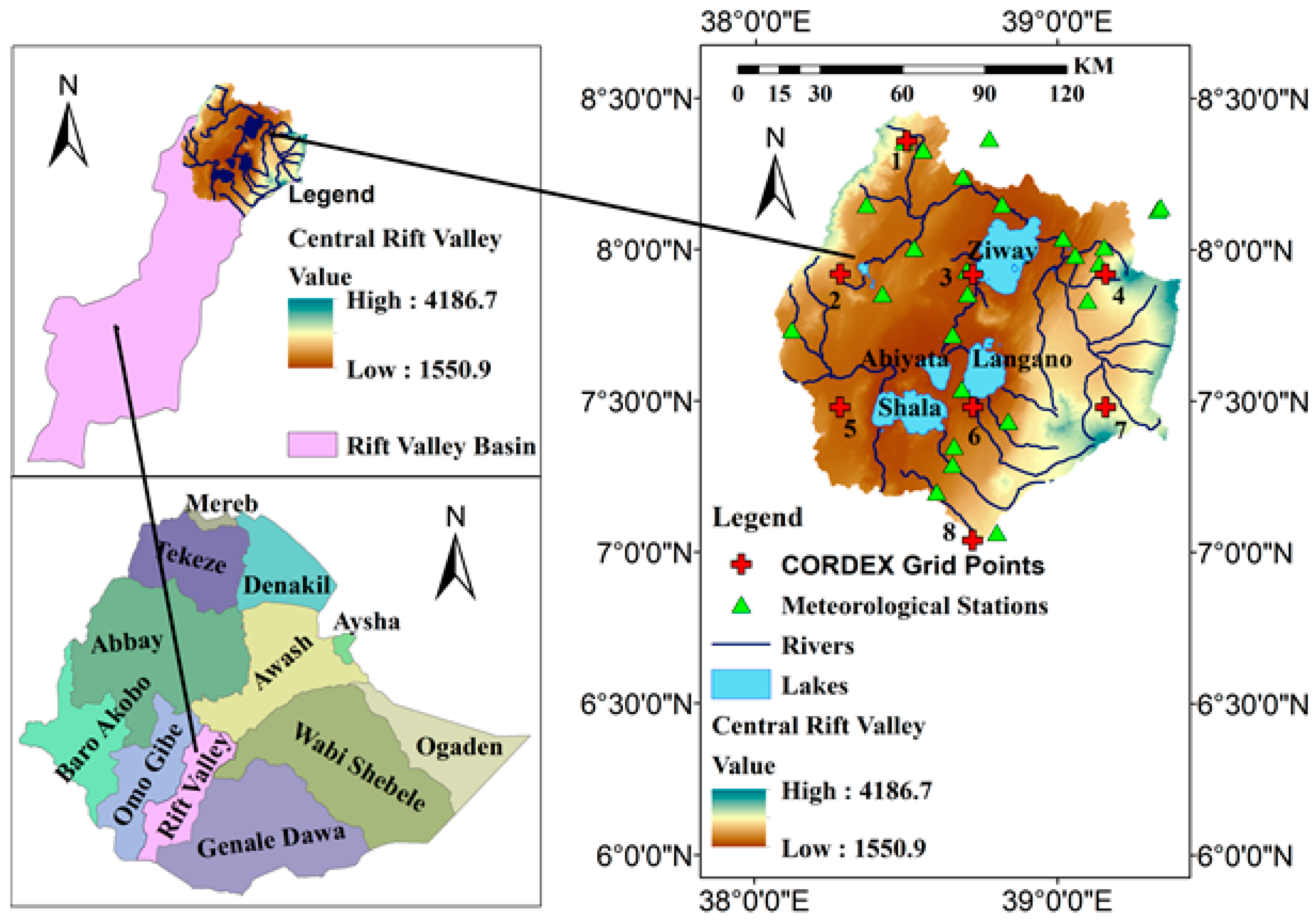
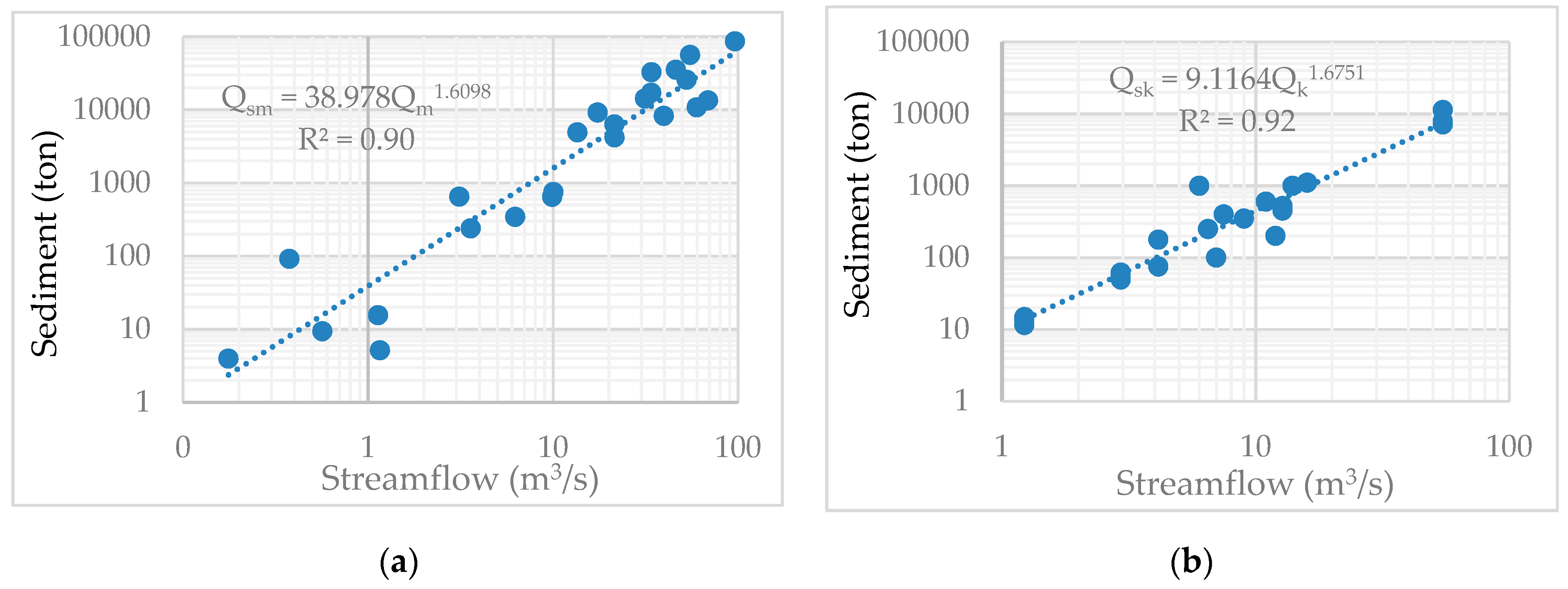
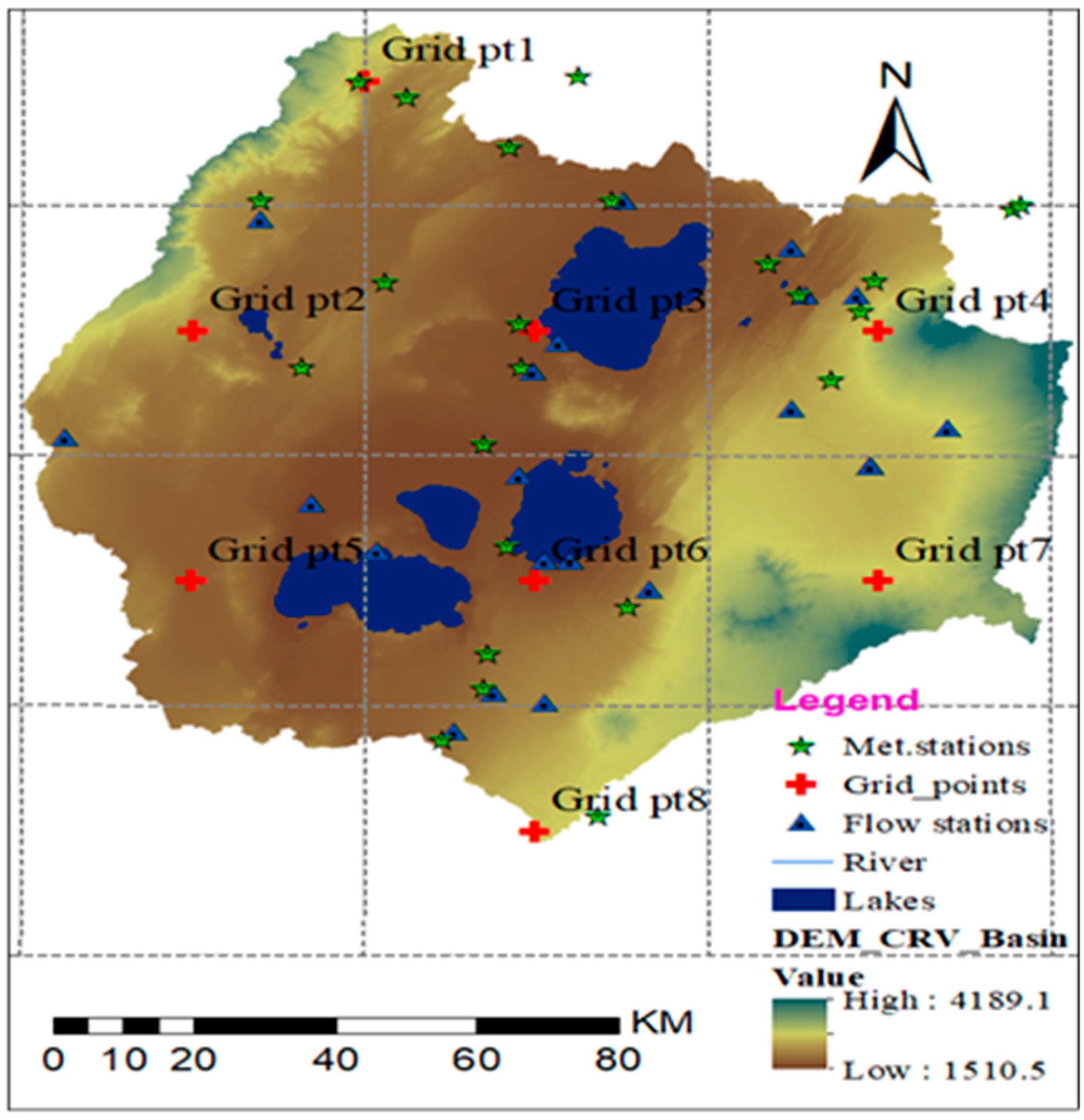
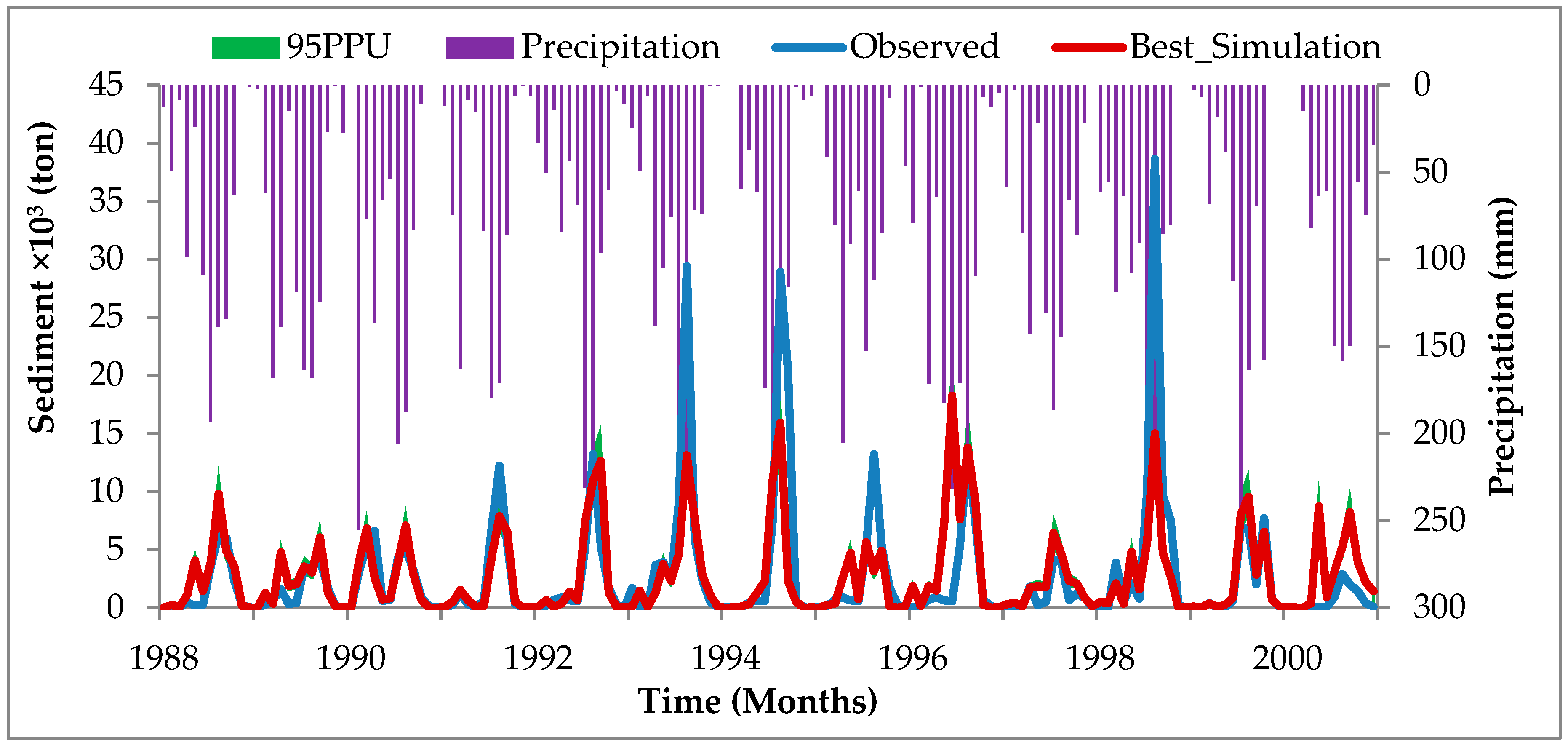
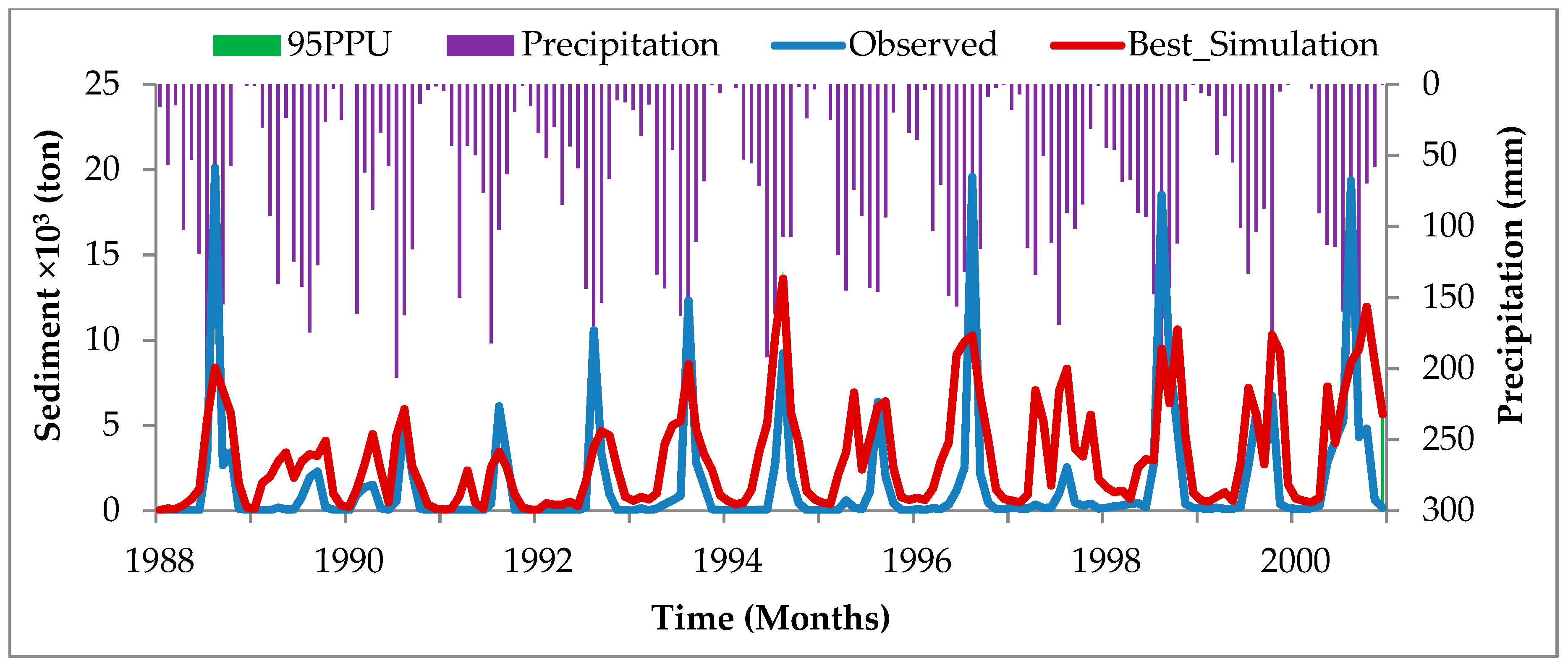
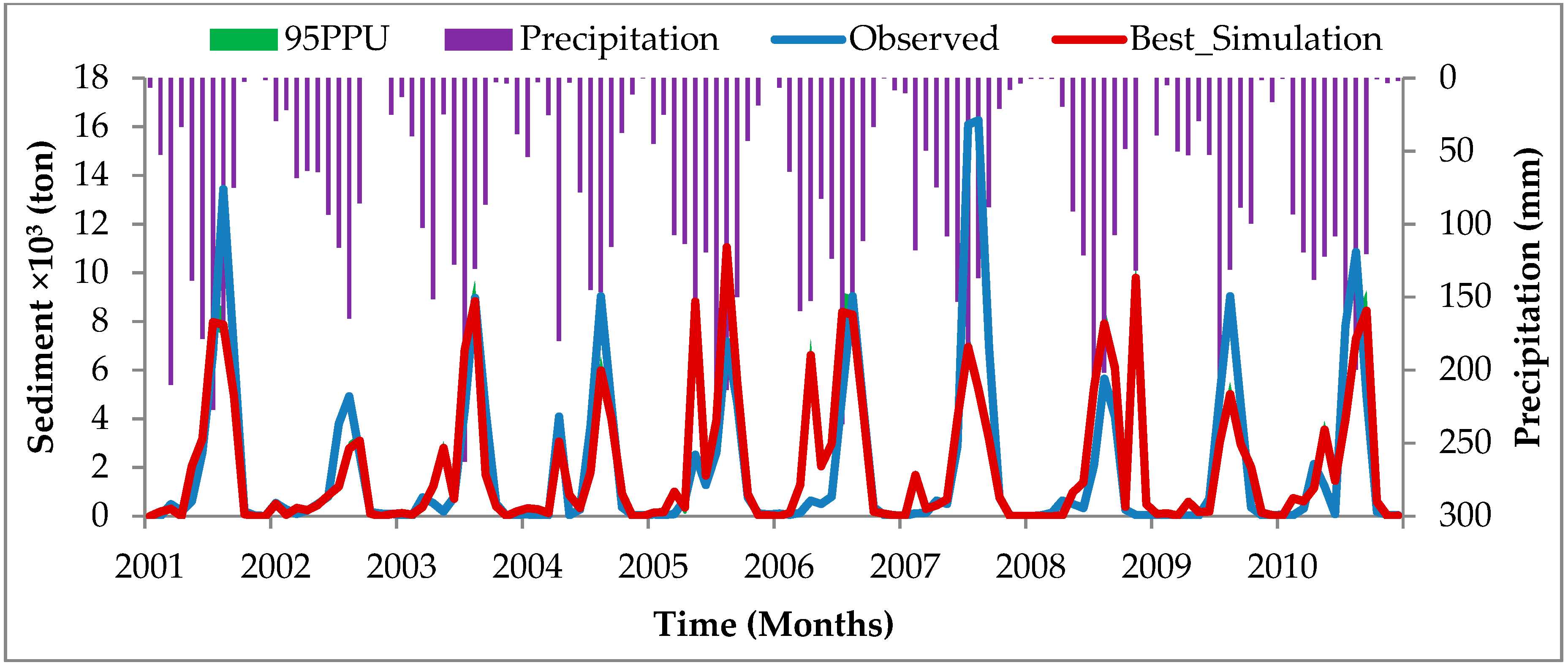
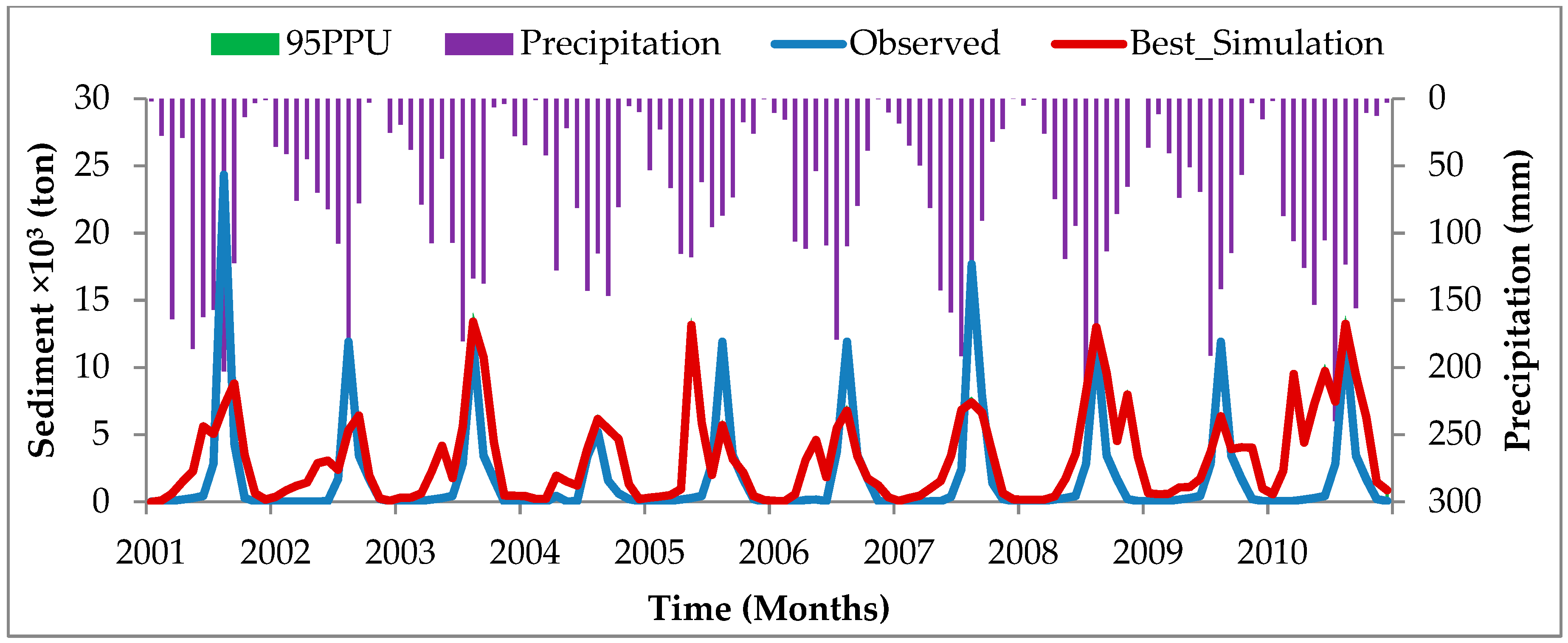
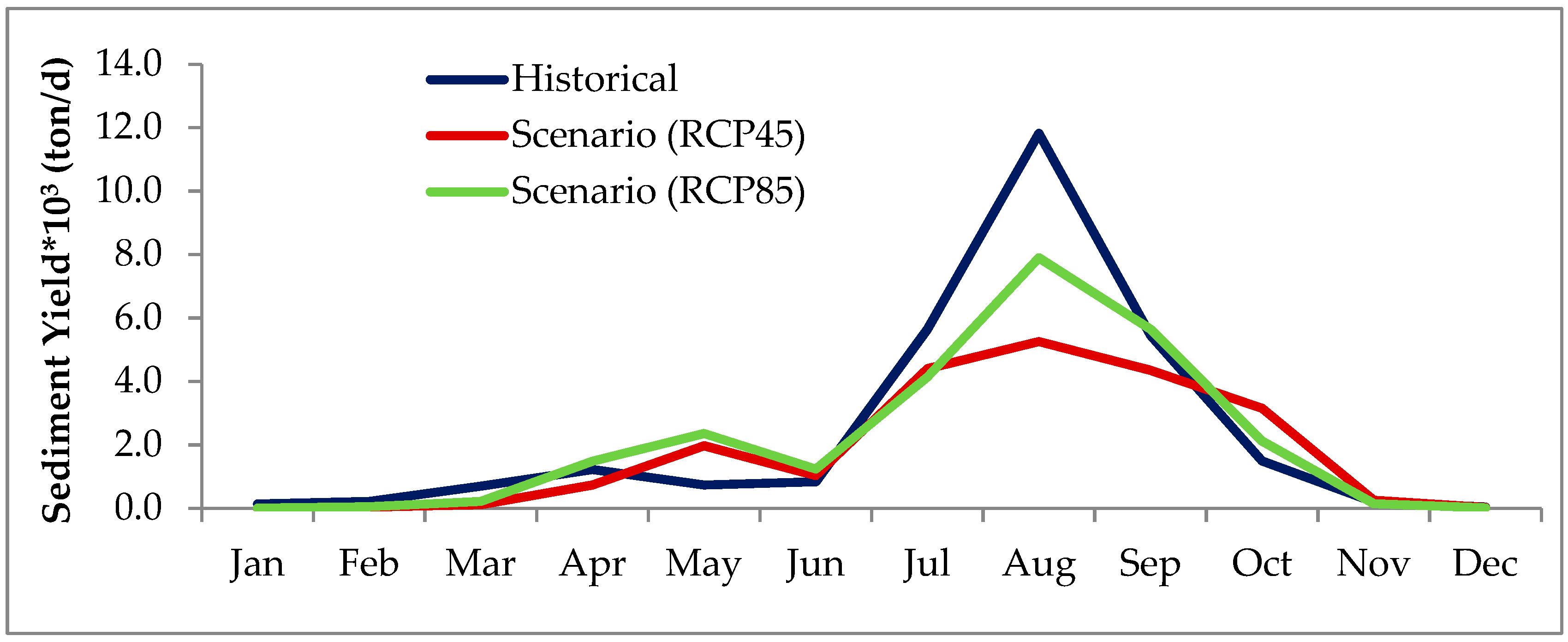
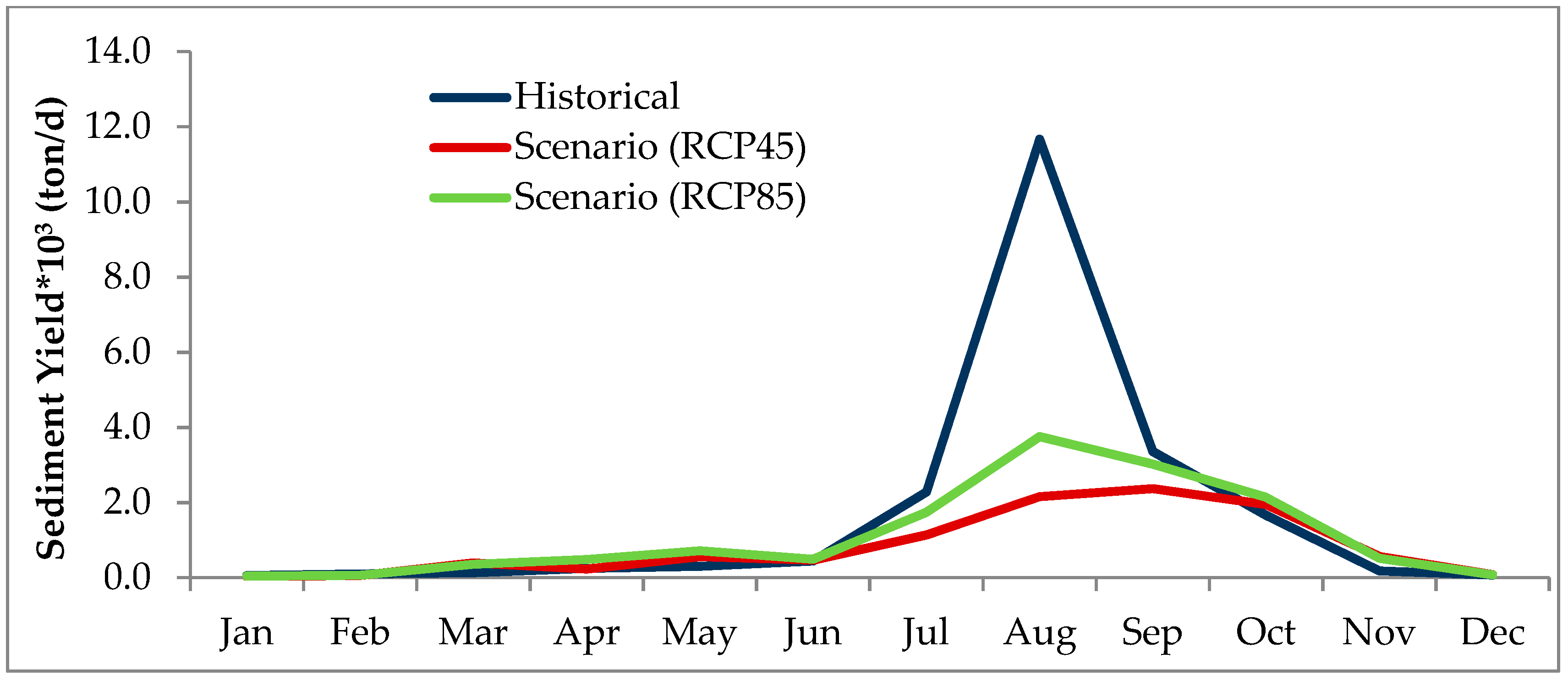
| Grid | Precipitation (%) | Maximum Temp | Minimum Temp | |||
|---|---|---|---|---|---|---|
| RCP4.5 | RCP8.5 | RCP4.5 | RCP8.5 | RCP4.5 | RCP8.5 | |
| 1 | −11.71 | −7.04 | +1.81 | +2.44 | +2.21 | +3.15 |
| 2 | −13.64 | −8.33 | +1.91 | +2.57 | +2.77 | +3.94 |
| 3 | −4.24 | 0.73 | +1.79 | +2.44 | +2.33 | +3.25 |
| 4 | −5.54 | 0.21 | +1.71 | +2.34 | +1.92 | +2.73 |
| 5 | −9.33 | −1.69 | +1.62 | +2.19 | +2.02 | +2.84 |
| 6 | −4.27 | 1.70 | +1.67 | +2.27 | +2.14 | +2.99 |
| 7 | −6.35 | −3.13 | +1.74 | +2.41 | +1.91 | +2.77 |
| 8 | −7.14 | −1.11 | +1.61 | +2.21 | +2.00 | +2.86 |
| Aver. | −7.78 | −2.33 | +1.73 | +2.36 | +2.16 | +3.07 |
| Parameter Name | Description | Rank | Fitted Value | ||
|---|---|---|---|---|---|
| Meki | Ketar | Meki | Ketar | ||
| R__CN2.mgt | SCS runoff curve number | 1 | 1 | −0.22 | 0.21 |
| V__ESCO.hru | Soil evaporation compensation factor | 2 | 10 | 0.37 | 0.67 |
| V__GWQMN.gw | Threshold depth of water in shallow aquifer | 3 | 9 | 4366.51 | 4237.00 |
| V__EPCO.hru | Plant uptake compensation factor | 4 | 11 | 0.28 | 0.92 |
| V__SLSUBBSN.hru | Average slope length | 5 | 2 | 6.41 | 78.50 |
| R__SOL_AWC(.).sol | Soil available water capacity | 6 | 8 | 0.43 | −0.13 |
| V__SURLAG.bsn | Surface runoff lag time | 7 | 6 | 4.25 | 14.05 |
| R__SOL_K(..).sol | Soil saturated hydraulic conductivity | 8 | 5 | 0.92 | 0.27 |
| V__ALPHA_BF.gw | Base flow alpha factor | 9 | 4 | 0.33 | 0.22 |
| V__GW_DELAY.gw | Groundwater delay | 10 | 3 | 398.06 | 208.54 |
| V__CH_K2.rte | Effective hydraulic conductivity in main channel | 11 | 7 | 498.53 | 454.88 |
| Parameter | Description | Fitted Value | Rank | ||
|---|---|---|---|---|---|
| Meki | Ketar | Meki | Ketar | ||
| SPCON | Linear re-entrainment parameter for channel sediment routing | 0.00011 | 0.00015 | 1 | 1 |
| SPEXP | Exponential re-entrainment parameter | 1.48734 | 1.1475 | 3 | 4 |
| CH_COV2 | Channel cover factor | 0.97351 | 0.9650 | 2 | 2 |
| CH_ERODMO | Channel erodibility factor | 1.01821 | 0.4850 | 4 | 3 |
| Gauging Station | Nash–Sutcliffe Efficiency (ENS) | Coefficient of Determination (R2) | ||
|---|---|---|---|---|
| Calibration | Validation | Calibration | Validation | |
| Meki | 0.56 | 0.52 | 0.54 | 0.50 |
| Ketar | 0.53 | 0.49 | 0.51 | 0.49 |
| River | Sediment Yield (ton/km2) | Change (%) | |||
|---|---|---|---|---|---|
| Historical | RCP45 | RCP85 | RCP4.5 | RCP8.5 | |
| Meki | 431.05 | 322.82 | 382.31 | −25.1 | −11.3 |
| Ketar | 323.82 | 157.06 | 211.00 | −51.5 | −34.8 |
© 2018 by the authors. Licensee MDPI, Basel, Switzerland. This article is an open access article distributed under the terms and conditions of the Creative Commons Attribution (CC BY) license (http://creativecommons.org/licenses/by/4.0/).
Share and Cite
Gadissa, T.; Nyadawa, M.; Behulu, F.; Mutua, B. The Effect of Climate Change on Loss of Lake Volume: Case of Sedimentation in Central Rift Valley Basin, Ethiopia. Hydrology 2018, 5, 67. https://doi.org/10.3390/hydrology5040067
Gadissa T, Nyadawa M, Behulu F, Mutua B. The Effect of Climate Change on Loss of Lake Volume: Case of Sedimentation in Central Rift Valley Basin, Ethiopia. Hydrology. 2018; 5(4):67. https://doi.org/10.3390/hydrology5040067
Chicago/Turabian StyleGadissa, Takele, Maurice Nyadawa, Fiseha Behulu, and Benedict Mutua. 2018. "The Effect of Climate Change on Loss of Lake Volume: Case of Sedimentation in Central Rift Valley Basin, Ethiopia" Hydrology 5, no. 4: 67. https://doi.org/10.3390/hydrology5040067
APA StyleGadissa, T., Nyadawa, M., Behulu, F., & Mutua, B. (2018). The Effect of Climate Change on Loss of Lake Volume: Case of Sedimentation in Central Rift Valley Basin, Ethiopia. Hydrology, 5(4), 67. https://doi.org/10.3390/hydrology5040067




